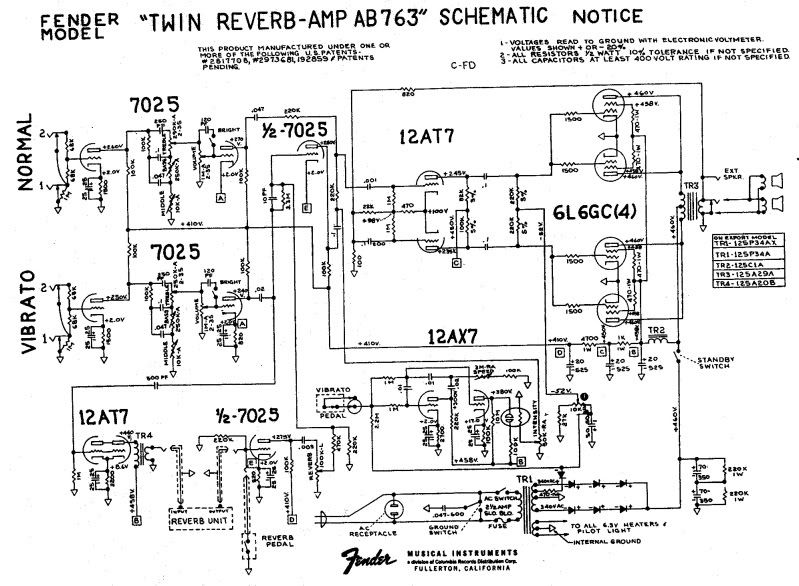First of all, I apologize because I'm almost certain this has probably been covered to death. But I have searched, and have not come up with a clear-cut answer to my question.
I have a transition black line Silver-Face Twin Reverb. I call it a transition, because it came with an AB763 Tag in the cabinet, and a hodge-podge circuit which appeared to be a combination of the AB763 and the AC-568 schematics. The power supply and bias circuits were AC568, however none of the strange power tube capacitors were present in this amplifier.
It has been less than reliable, so I stripped it to the chassis, and completely rebuilt it to AB763 specs, with a couple of minor mods including changes to the normal channel, and the addition of a dwell control to the reverb. To the best of my knowledge, these changes should have no effect on the power tube bias.
I converted the bias pot to the AB763 arrangement. Biasing is such a grey area for me, and I'd like to correct that here.
The AB763 Schematic specifies a voltage of -52V at the junction of the two 220K resistors that feed all the grids of the power tubes. I installed a 1 ohm resistor on one of the output tube cathodes (should I do this to all of them??) and measured the voltage to be around 10mV, for a current draw of around 10mA. This is with the voltage set to -52V per the schematic. Clearly this is way too low. Do I bother worrying about the voltage posted on the schematic?
I have searched here and the internet like crazy, and I cannot find any specific suggested current to bias the tubes on the Twin. I have seen everything from 20mA to 35mA, which is a huge discrepancy. I can get it as high as 24mA before I run out of range on my pot. I will need to change the fixed resistor to deal with that, but then I will be very far away from the original -52V suggestion.
Here's some other useful information: The B+ voltage on my amp is 435V, and the voltage at the plates of the output tubes is 408V on all four.
Rumor has it the Twin was supposed to be rated at 80W, which to me means 20W per tube. If my Math is correct, 20/408 = 49mA.
I read something about a 70% rule, regarding Class AB amplifiers. So if that has any weight, Assuming a 6L6 is a 25W tube, 25*.7 = 17.5W 17.5/408 seems like a more reasonable 42mA.
Both 49mA and 43mA both greatly exceed the currents that I have seen suggested here and there, and rapidly bring that -52V closer to ground.
What to do?!

I have a transition black line Silver-Face Twin Reverb. I call it a transition, because it came with an AB763 Tag in the cabinet, and a hodge-podge circuit which appeared to be a combination of the AB763 and the AC-568 schematics. The power supply and bias circuits were AC568, however none of the strange power tube capacitors were present in this amplifier.
It has been less than reliable, so I stripped it to the chassis, and completely rebuilt it to AB763 specs, with a couple of minor mods including changes to the normal channel, and the addition of a dwell control to the reverb. To the best of my knowledge, these changes should have no effect on the power tube bias.
I converted the bias pot to the AB763 arrangement. Biasing is such a grey area for me, and I'd like to correct that here.
The AB763 Schematic specifies a voltage of -52V at the junction of the two 220K resistors that feed all the grids of the power tubes. I installed a 1 ohm resistor on one of the output tube cathodes (should I do this to all of them??) and measured the voltage to be around 10mV, for a current draw of around 10mA. This is with the voltage set to -52V per the schematic. Clearly this is way too low. Do I bother worrying about the voltage posted on the schematic?
I have searched here and the internet like crazy, and I cannot find any specific suggested current to bias the tubes on the Twin. I have seen everything from 20mA to 35mA, which is a huge discrepancy. I can get it as high as 24mA before I run out of range on my pot. I will need to change the fixed resistor to deal with that, but then I will be very far away from the original -52V suggestion.
Here's some other useful information: The B+ voltage on my amp is 435V, and the voltage at the plates of the output tubes is 408V on all four.
Rumor has it the Twin was supposed to be rated at 80W, which to me means 20W per tube. If my Math is correct, 20/408 = 49mA.
I read something about a 70% rule, regarding Class AB amplifiers. So if that has any weight, Assuming a 6L6 is a 25W tube, 25*.7 = 17.5W 17.5/408 seems like a more reasonable 42mA.
Both 49mA and 43mA both greatly exceed the currents that I have seen suggested here and there, and rapidly bring that -52V closer to ground.
What to do?!


Comment